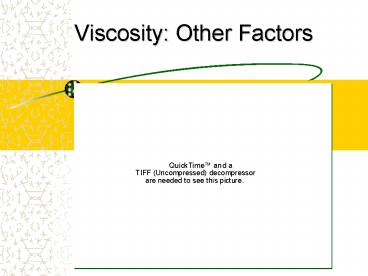Viscosity: Other Factors - PowerPoint PPT Presentation
1 / 24
Title:
Viscosity: Other Factors
Description:
Pressure The viscosity of most foods does not vary at pressures between 0-100 atm Solute Molecular Weight Typically, viscosity increases with MW Non-linear ... – PowerPoint PPT presentation
Number of Views:190
Avg rating:3.0/5.0
Title: Viscosity: Other Factors
1
Viscosity Other Factors
2
Pressure
- The viscosity of most foods does not vary at
pressures between 0-100 atm
3
Solute Molecular Weight
- Typically, viscosity increases with MW
- Non-linear relationship
- The intrinsic viscosity often follows the
Mark-Houwink relationship - h KMa
4
The slope contains information about the shape of
the molecule a 0.5 ? flexible polymer chain
in ideal solvent 0.5 lt a lt0.8
?flexible polymer chain in good
solvent a gt 0.8 ? stiff chain
5
Macromolecule Solvent K x 102 a
Polystyrene Benzene 0.95 0.74
Amylose 0.33N KCl 11.3 0.50
Various proteins 6M guanidine HCl 0.1M b-MeSH 0.716 0.66
PVOH Methanol 0.02 0.76
6
(No Transcript)
7
Source Viskotek
8
- For many polymers, viscosity varies with chain
length Zw - A critical chain length (Zc) exists, such as
- Below Zc
- Above Zc
9
(No Transcript)
10
11
General Theory
- Albert Einstein (1906) describes viscosity of
solutions containing rigid spheres - When particles are introduced to a fluid, more
force is required to maintain same shear rate.
Particles dont deform, so fluid must be forced
around them
12
(No Transcript)
13
The viscous drag depends on the volume fraction
of particles
Medium f
Low volume fraction f
High volume fraction f
14
where n is a shape factor ( 5/2 for spheres)
15
For concentrated solutions
Expressed in terms of concentration
h KMa
16
Concentration
- Generally, viscosity increases with concentration
of solute. A power law may apply over limited
concentrations
17
http//www.fao.org/docrep/field
18
Akucell cellulose gum
19
(No Transcript)
20
Ions may interact with polymers
21
Suspended Particles
- Particles usually increase viscosity slightly at
low concentrations - More effect at higher concentrations, and leads
to pseudoplastic behavior - Fruit and vegetable juices, purees
22
http//ciks.cbt.nist.gov/garbocz
23
(No Transcript)
24
(No Transcript)































